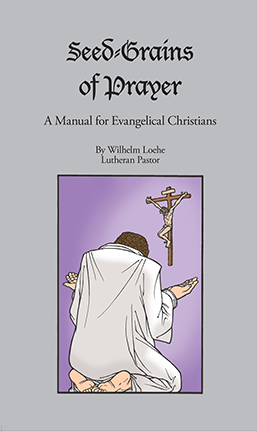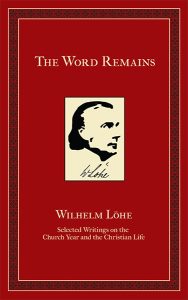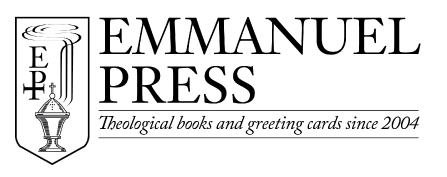THE LATEST NEWS
Seed Grains of Prayer: A Prayer for Good Friday

“Almighty, eternal God, Who for us hast caused Thy Son to suffer the pains of the cross, that Thou mightest put away the power of the enemy from us, grant so to observe the memory of His suffering that we may attain to the forgiveness of sin, and the surety of release from eternal death, to serve Thee in everlasting righteousness, innocence, and blessedness. Amen.”
-W. Loehe in Seed Grains of Prayer
The Word Remains: Regarding Nature
 “The world is beautiful. I’ve said that to myself a thousand times as I walk through the greening meadows in the spring and listen to the song of the lark. But we Christians must be mindful not to speak of the beauty of nature with such expression, with such rapture, as if indifferent to the obvious groaning and sighing all around, of which our text speaks (Rom. 8:18-23). Just look at the animals with their mute, joyless, pleading eyes; isn’t their sighing evident? The stark mountains and the naked cliffs, which are scattered out under the sky like old bones, weep with the anxious expectation of rebirth.”
“The world is beautiful. I’ve said that to myself a thousand times as I walk through the greening meadows in the spring and listen to the song of the lark. But we Christians must be mindful not to speak of the beauty of nature with such expression, with such rapture, as if indifferent to the obvious groaning and sighing all around, of which our text speaks (Rom. 8:18-23). Just look at the animals with their mute, joyless, pleading eyes; isn’t their sighing evident? The stark mountains and the naked cliffs, which are scattered out under the sky like old bones, weep with the anxious expectation of rebirth.”
-Wilhelm Löhe in The Word Remains (p. 61)
*It is worth noting that Löhe lived from 1808 to 1872, during the time of Romanticism, which was characterized by an emphasis on emotion and a glorification of nature.
Announcing….our book cover artist!
While brainstorming ideas for the new book cover for He Remembers the Barren, Second Edition by Katie Schuermann, we knew that we wanted artwork that would tell the story of suffering and grief but also of hope and comfort in Christ. To bring this idea to fruition, we decided to tap into the artistic talent and theological insight of Edward Riojas, an artist who excels in bringing rich symbolism into the finest details. What Riojas is creating for us promises to be tender and honest and Christological, beautifully echoing the poignant and expressive words we find in Katie Schuermann’s writing.
We look forward to revealing the cover to you this spring! In the meantime, we encourage you to like Riojas’ Facebook page and browse his website to learn more about his artwork and the giclee prints he offers. Also be sure to read his latest blog post, “What Colors Confess,” which explores the theological nuance of color choice when painting our Lord and other sacred artwork.
__________
Bio from his website: Edward Riojas has been creating artwork professionally for 35 years — maybe more. He received a fine art degree, then worked a three-year stint in advertising before spending nearly 31 years in the newspaper industry.
Riojas has built a reputation in the secular and sacred realms as a masterful illustrator and fine artist. His sacred, representational style has been likened to the Northern Renaissance, but Riojas can also throw a goofy curve ball when it comes to illustration. Today, his work is found in sanctuaries, institutions, private collections and markets throughout the U.S. and across the globe.
An Excerpt from Quinquagesima Sunday
 “We mourn for our sins. We have been selfish, greedy, impatient, angry, lustful, and full of pride. We have hurt ourselves and our loved ones. We have failed to serve and love our neighbors. Let us repent and set our faces toward Jerusalem. Ash Wednesday looms close. We prepare for the journey. For we know that we have been too attached to this world, too afraid to leave behind the pleasures of the flesh. We are desperately in need of a Savior.
“We mourn for our sins. We have been selfish, greedy, impatient, angry, lustful, and full of pride. We have hurt ourselves and our loved ones. We have failed to serve and love our neighbors. Let us repent and set our faces toward Jerusalem. Ash Wednesday looms close. We prepare for the journey. For we know that we have been too attached to this world, too afraid to leave behind the pleasures of the flesh. We are desperately in need of a Savior.
But for all that, let us not sorrow for the love of God that has sent the Son to be handed over to the Gentiles, to be mocked, shamefully treated, spit upon, flogged, and crucified. In that, rather, let us give thanks and rejoice. Let us be like the cured blind man, following to
Jerusalem, glorifying God, knowing that leaving behind our sins is like leaving behind blindness. What do you want? To be free of sin, O Lord.”
-David H. Petersen in Thy Kingdom Come: Lent and Easter Sermons
Emmanuel Press to release second edition of Katie Schuermann’s He Remembers the Barren
We are excited to announce a partnership with Katie Schuermann to publish the second edition of her breakthrough debut, He Remembers the Barren. First published in 2011, He Remembers the Barren is a tender conversation with women in the church who wrestle with the issue of barrenness in marriage. Schuermann offers encouragement and support to those struggling with infertility, gently addressing issues such as control of our bodies, family planning, adoption, and the source of conception, all while reminding the reader of her clear vocation in Christ and pointing her to the ultimate source of fruitfulness, vitality, and comfort: our Triune God. This book is not only for barren women but also for anyone seeking insight into suffering and hope; Schuermann focuses on our identity in Christ, told through the lens of barrenness.
As the author notes, “Eight years have passed since I first began writing He Remembers the Barren, and the time is ripe for a second edition. I have grown in my knowledge and understanding of the topic of barrenness, both through personal experience and study, and I would like my confession of the theology of the cross in the book to proclaim more clearly how our heavenly Father disciplines us, His dear children, through the gift of suffering in this life. I also feel compelled to better and further address the topics of adoption and the ethical issues surrounding in vitro fertilization and other such procedures utilized in the field of infertility medicine.”
While much of the original book’s content will remain, the reader can expect revisions throughout as well as new chapters and a Q & A appendix helpful for those who desire children and for their loved ones who wish to serve and comfort them. The second edition will also contain questions for discussion and contemplation, providing for both individual and group study. New cover artwork will capture the grief and suffering of barrenness but also the hope and comfort found in Christ.
We anticipate the release date to be early this summer. More details to come!
To learn more about the author, visit www.katieschuermann.com.

Let’s stay in touch! To receive the most current information on our products and new releases, join our email list today!

